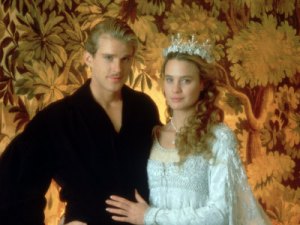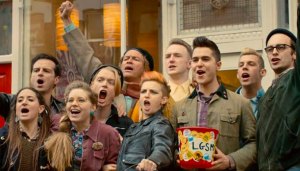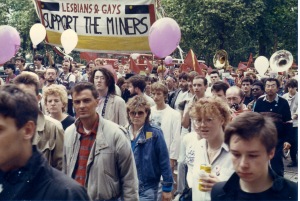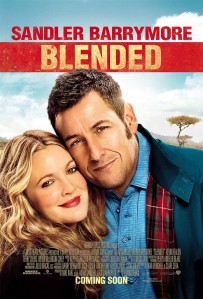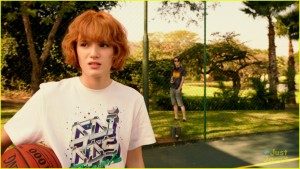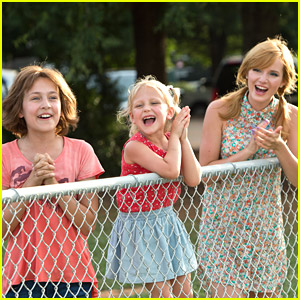Last week when Taylor Swift’s new single Look What You Made Me Do hit the airways, I was devastated. While the album name ‘Reputation’ seemed promising, the lyric video seemed to confirm that Tayswi – Queen of the Secret Lesbian Club of Hollywood – was only interested in making a petty jab at Kanye West via a mostly terrible pop song. My god, I thought. Is Taylor just completely basic?

Please never watch the lyric video. Ever.
But when the new video directed by Joseph Khan dropped, all of my doubts perished, because THIS IS WITHOUT A DOUBT THE GAYEST TAYSWI VIDEO OF ALL TIME. (And by gayest of course I mean open to a queer reading i.e. seeing things sideways, and reading LGBTQ themes into things). Unsurprisingly the mainstream media are calling this Tayswi’s “shade” video which is simply about mocking all of her haters. They are entirely skimming over all the gay bits that they can’t make sense of (never mind that queers invented shade).
So bear with me for the incredibly long journey that is a queer reading (or really, just the most obvious and true and direct reading) of LWYMMD…
The opening shots lead us to a graveyard:

This is surely an obvious story about Taylor’s trashed reputation, no?
Well, we are also immediately reminded of Leo Bersani’s famous paper Is the Rectum a Grave?, written in 1987 at the time when the peak of the AIDs crisis was unfolding in the USA. In Bersani’s paper he tracks the homophobic response to AIDS, but also how misogyny is also implicated in homophobia, where femininity is conflated with the “passive” bottom position in gay male sex. Bersani urges us to embrace the subordinate feminine/homosexual position as a way to contest and shatter hierarchies of power.
Here we see Taylor trying to “bury” her gaping grave that reveals her vulnerability/femininity/homosexuality:

At the bottom of the grave we see 2014 circa Swift in her Met Ball gown, the same year of the peak rumours that her and Karlie Kloss were in a relationship:

Much like the imagery of the video for Bad Blood (also directed by Khan) we appear to be transported to an “underground” world. We might recall that in that clip the underground involved an Amazonian-like alternate reality:

But in this underground, Taylor isn’t fighting, she’s in a bath full of diamonds:

While diamonds symbolise wealth, she’s not sitting in a pit of money – most clearly here we are called to think of Marilyn Monroe’s Diamonds are a Girl’s Best Friend:
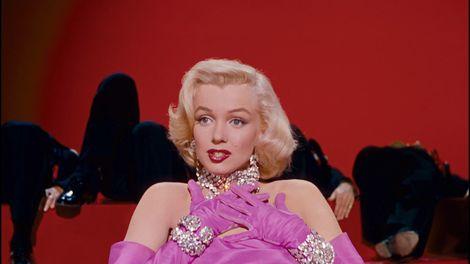
Not only was Monroe herself a famously closeted gay icon, the original song has some rather queer lyrics: “Time rolls on/And youth is gone/ And you can’t straighten up when you bend”.
Taylor’s bath is also in the centre of a room full of mirrors, recalling the saying “hall of mirrors” where one is not able to distinguish fact from fiction. But we also need to recall the intertextual reference to her earlier clip for Style, which is all about duality:

We might also note the rainbows evident in this clip:

And the tension between the internal masculine/feminine:
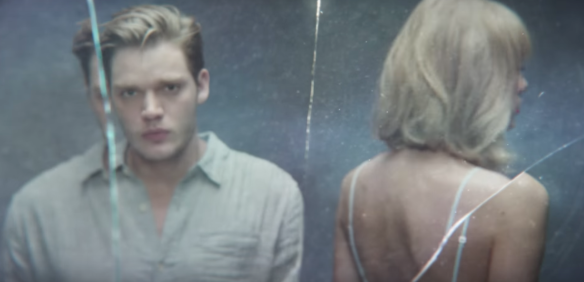
A theme which is also represented in Bad Blood:

But back to LWYMMD, we are met with our first glimpse of snakes:
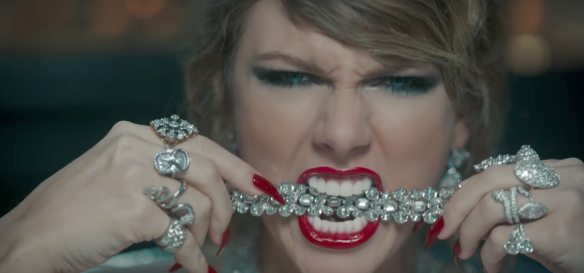
Which are mostly obviously a reference to Kimye’s attack on Taylor after the Famous shenanigan. BUT what about the fact that snakes appear on Taylor’s hands in a lot of her earlier video clips? For example, Style:
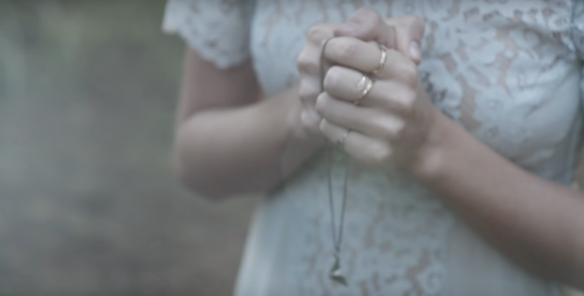

And Blank Space:
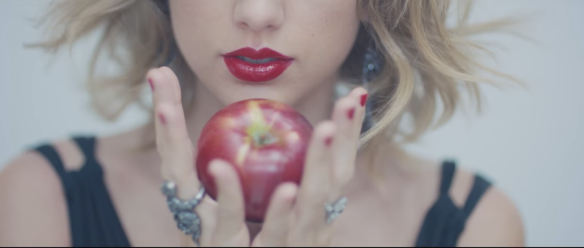
The fact that Taylor wears many of these snakes as rings is also significant in light of her earlier ring choices, notably the fleur-de-lis of Our Song, representing chastity:

So, Taylor has gone from a symbol of chastity, to snakes, which coincidentally are strongly associated with sexuality due to that whole Adam-and-Eve-snake-incident-thing. In other words, snakes are traditionally understood as representing sexual power. For Freud snakes were a symbol of male sexual drive, but lesbian culture has also embraced the snake namely in reference to the ancient matriarchal Minoan society symbolised by the “Snake Goddess”:
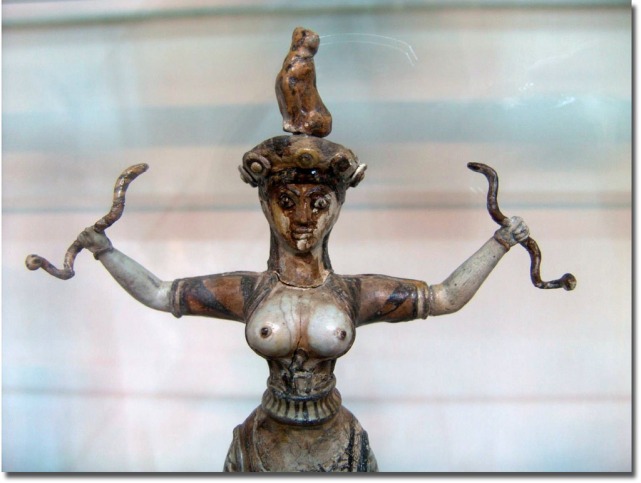
We then see that Taylor is indeed positioning herself as snake queen:
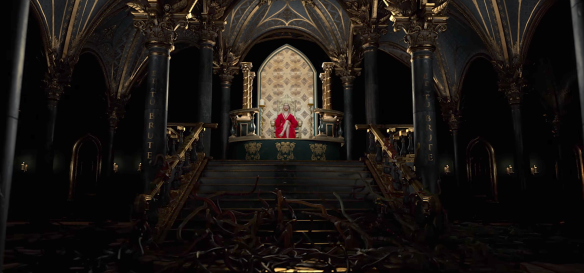
But she’s not only queen of snakes i.e. queen of sexual power, she’s drinking tea:
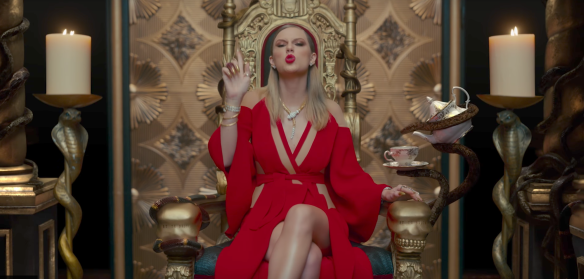
Which seems kind of random UNTIL we recall that tea is associated with the gay community as Urban Dictionary defines: “Used within the urban gay community, ‘tea’ signifies a piece of sensitive and possibly highly sought-after information or tidbit”. Or, as A.J. Musser has argued: “While I do not want to argue that tea functions as the sign of lesbianism, it does serve as one among a collection of possible signs of female queerness”. So, here the tea drinking is not only about recalling a secret, it is a nod to lesbian stereotypes. In light of this we might see the “et tu Brute” chiselled into the columns as not only referencing Kanye as a backstabber, but perhaps also calling him out of the closet – i.e. “and you, Kanye?”
Next up it’s Taylor in an epic golden car crash, and as everyone has pointed out, she looks just like Katy Perry (but holding the grammy Katy doesn’t have – so shady):
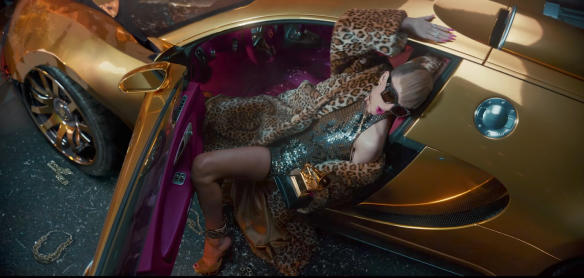
Up until recently the reason behind Katy and Taylor’s famous feud wasn’t known. Katy has since explained that it was about backing dancers. Are we really to believe that Taylor wrote Bad Blood, which features the lyrics “You know it used to be mad love” just because of a fight about backing dancers?
Maybe Taylor is trying to reference Judith Butler’s theory of gender melancholy here – you become what you cannot love…(And, not to mention that Katy came out earlier this year).

We then see Taylor the caged bird, calling to mind Maya Angelou’s I Know Why the Caged Bird Sings, which explores questions of lesbianism among other themes. We might also note that Taylor is in an orange jumpsuit behind bars, a la Orange is the New Black.

But importantly, Taylor’s “feast” in the cage involves a lobster and a rat:

While rats are symbolic of new beginnings, and lobsters also represent regeneration, “lobster” is slang for “lesbian”.
We are then taken to scenes of Taylor robbing what appears to be a music streaming company. But this isn’t just about her feud with Apple, she’s also sporting the very pansexual slogan “BLIND FOR LOVE” amongst a bevy of cats/pussies:
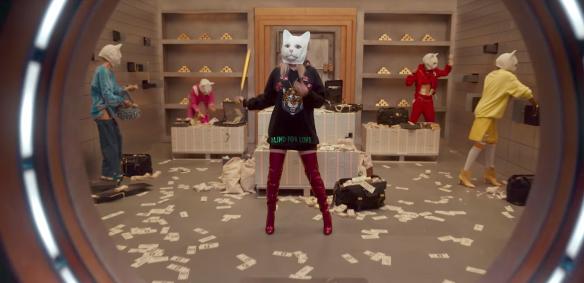
Of course Taylor has been upfront about her obsession with cats for some time (also a lesbian stereotype), as we see in early videos such as 22 (where she just happens to be hugging a woman while making a “V” sign…):
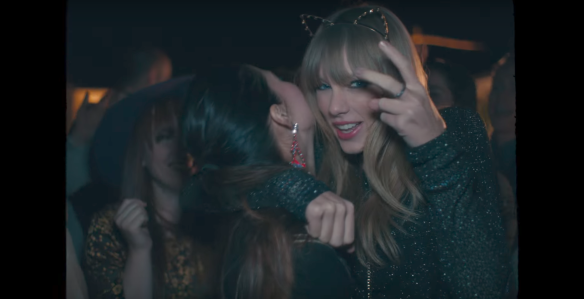
And lobsters/cats aren’t the only animal symbolism Taylor has used in videos – remember that beaver from We Are Never Ever Getting Back Together who (along with a random woman) beckons Taylor away from her bed/phone call with her boyfriend?

Back in LWYMMD, things take a turn for the extra gay, with Taylor referencing Dykes on Bikes (a lesbian pride group which began in San Francisco in the 1970s):

While some have suggested this is undoubtably a reference to Peter Lindberg’s “Wild at Heart” shoot for Vogue in 1991, there is no doubt that the inspiration for that was this:

We then see Taylor as the dominatrix leader of a “squad” of plastic women (note the cats also on screen – it’s her “pussy squad”), in reference to her infamous girl gang groupies:

While the figure of “dominatrix” has its own overt sexual connotations, the imagery (as Every Outfit on SATC has pointed out) is clearly referencing the 2016 horror film Neon Demon:
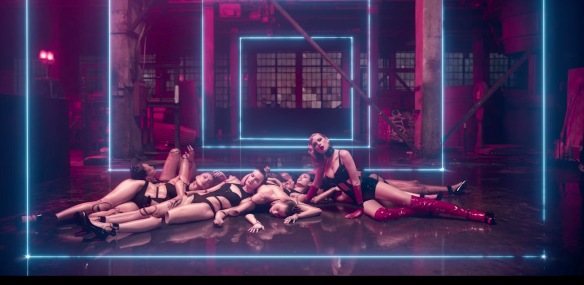
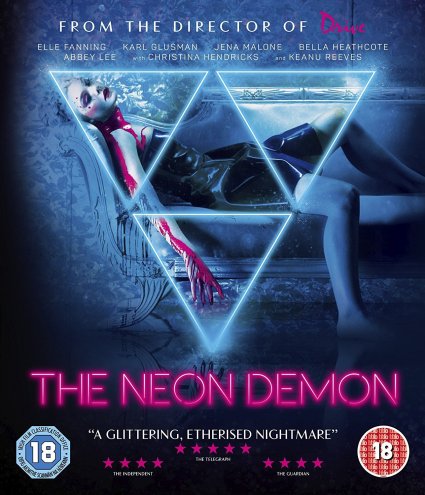
WHICH notoriously includes an extended scene involving lesbian necrophilia.
Taylor then bursts in to the metaphorical closet:

Which also calls to mind the “door” in her clip for Fifteen where she is 800% in love with a girl and is just a completely gay story for real (lyrics include “you might find who you’re supposed to be…take a deep breath and walk through the doors”):
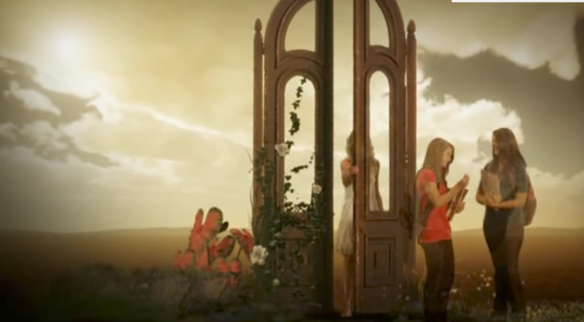
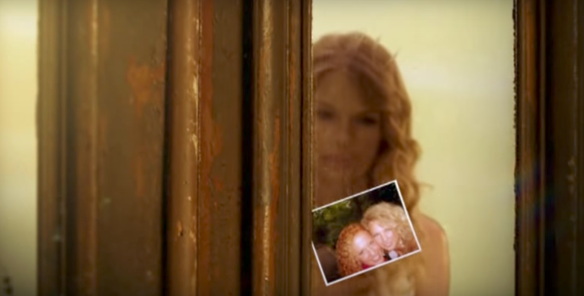
In the LWYMMD closet she doesn’t meet her teen girl crush, but rather a crew of effeminate men in heels, including the notable and openly gay Todrick Hall. A lot of commentators have pointed to the “I ❤ T.S.” on the men’s shirts as a jab at Taylor’s supposed ex-boyfriend Tom Hiddleston who wore a similar shirt when they were said to be dating:

But I think the real takeaway message here is the association between those who declare their love for Taylor, and being gay/closeted. In other words this whole scene is about Taylor’s beards.

The finale is Taylor standing on a pile of warring alter-egos (and of course the “T” referencing not only “Taylor” but the “tea” earlier in the clip):
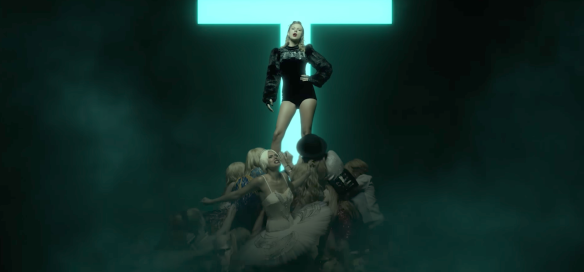
Up the front we have Taylor in her Swan Lake outfit from Shake it Off, and given that this particular character was chosen out of a cast of many from that particular clip, we might also see this as a reference to the lesbian horror (see a theme here?) film Black Swan:

With feminine horror also referenced in Taylor’s outfit as she saws the wings off a phallic aeroplane:

In the final scene Taylor once again meets the many sides of “herself”:
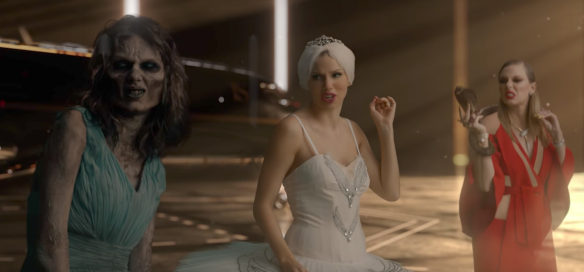
A theme of self-confrontation we have also seen in earlier clips like Out of the Woods:

But while Taylor’s previous clips have been about “finding” herself, it is clear in LWYMMD that we the audience have not yet found the “true” Taylor.
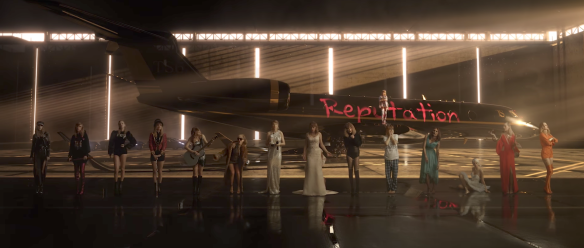
Or, maybe she’s all and none of these characters. Maybe she’s been trying to flag her sexuality for the longest time, with her snake rings, masculine internal duality, tea, rainbows, closet doors, lobsters, beavers and cats. I guess only time, and the rest of Reputation may tell.
(Thanks also to Clare S for helping with this piece, specifically the research on lesbians and tea).

 While the closure of the film was a little clunky (and I wondered if they actually had a few different endings in mind), overall First Girl I Loved is utterly engrossing. The opening scenes are framed tightly and closely around the protagonists, and we remain at eye level, almost as if we are right there with them – behind the softball fence, lingering at the doorway to the bedroom, walking down the street sipping $4 wine. We’re next to them all the way, not as a voyeur, but as a friend along for the ride.
While the closure of the film was a little clunky (and I wondered if they actually had a few different endings in mind), overall First Girl I Loved is utterly engrossing. The opening scenes are framed tightly and closely around the protagonists, and we remain at eye level, almost as if we are right there with them – behind the softball fence, lingering at the doorway to the bedroom, walking down the street sipping $4 wine. We’re next to them all the way, not as a voyeur, but as a friend along for the ride. Gelula’s performance is very commendable. She strikes a delicate balance between unbearable apathetic teen, and captivating hero that we want to succeed. Through Anne we see just how brilliant and strong teens can be, even if they’re totally clueless. Teens are often denigrated by society writ-large for being naive, but First Girl I Loved shows the pain and beauty of fumbling through, the intelligence involved in not knowing but pushing on nonetheless. The awkward innocence of Anne and Sasha’s interactions is wonderfully executed, and there was something so familiar about their veiled giggling banter that I felt like I was watching my young self up on screen.
Gelula’s performance is very commendable. She strikes a delicate balance between unbearable apathetic teen, and captivating hero that we want to succeed. Through Anne we see just how brilliant and strong teens can be, even if they’re totally clueless. Teens are often denigrated by society writ-large for being naive, but First Girl I Loved shows the pain and beauty of fumbling through, the intelligence involved in not knowing but pushing on nonetheless. The awkward innocence of Anne and Sasha’s interactions is wonderfully executed, and there was something so familiar about their veiled giggling banter that I felt like I was watching my young self up on screen. As I sat watching the film unfold, I found myself desperately wanting things to work out for the characters. I wanted it to end happily not only because I was so engrossed in the story, but because happy endings for gay characters are so few and far between. It’s been great to see more films coming out that address romance between women, like
As I sat watching the film unfold, I found myself desperately wanting things to work out for the characters. I wanted it to end happily not only because I was so engrossed in the story, but because happy endings for gay characters are so few and far between. It’s been great to see more films coming out that address romance between women, like  While I can imagine some queer theorists arguing that the lack of traditionally happy endings for gay films is welcome, because who wants to live up to that heteronormative expectation anyway, it’s also pretty shit to constantly have popular culture either ignore your relationship or portray it is an inevitably difficult affair. While there is something to be said for representing the reality of homophobia and the difficulty of queer life, it is a pain that everyone else gets the option of fantasy (because let’s be real it’s not like heterosexual life really ends happily for everyone) except for gays who must remain proper realists.
While I can imagine some queer theorists arguing that the lack of traditionally happy endings for gay films is welcome, because who wants to live up to that heteronormative expectation anyway, it’s also pretty shit to constantly have popular culture either ignore your relationship or portray it is an inevitably difficult affair. While there is something to be said for representing the reality of homophobia and the difficulty of queer life, it is a pain that everyone else gets the option of fantasy (because let’s be real it’s not like heterosexual life really ends happily for everyone) except for gays who must remain proper realists. First Girl I Loved is no romcom, and it is serious. But it does manage to deal with difficult issues and give us a sense of both catharsis and hope, even as it leaves many things unresolved. It doesn’t make the empty promise that so many teens are barraged with that “it gets better”, but it does suggest that queer kin can be found and that inner strength is possible while traversing difficult and unknown terrain. First Girl I Loved gifts its audience a small beam of light for navigating this path, and for that it should be celebrated.
First Girl I Loved is no romcom, and it is serious. But it does manage to deal with difficult issues and give us a sense of both catharsis and hope, even as it leaves many things unresolved. It doesn’t make the empty promise that so many teens are barraged with that “it gets better”, but it does suggest that queer kin can be found and that inner strength is possible while traversing difficult and unknown terrain. First Girl I Loved gifts its audience a small beam of light for navigating this path, and for that it should be celebrated.




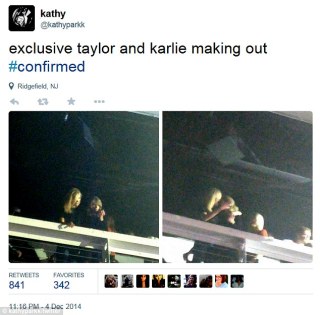 There was that time she apparently kissed Karlie Kloss
There was that time she apparently kissed Karlie Kloss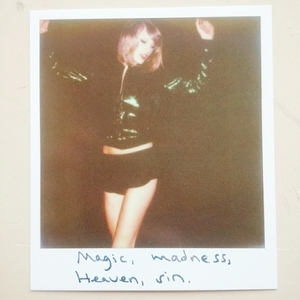 Swift’s new single off 1989 includes
Swift’s new single off 1989 includes 




